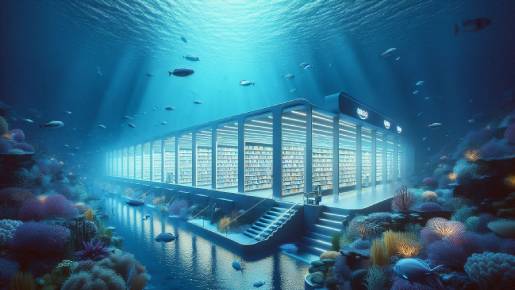What If Your Amazon Order Was Stored Underwater? Picture this:
Instead of sitting in a land-based warehouse, your package floats beneath the surface of a massive water tank, waiting to be delivered. It sounds like science fiction, but Amazon has already patented this groundbreaking idea.
This innovative patent could transform logistics, storage efficiency, and global supply chains. Let’s explore what Amazon’s underwater warehouse concept is, why it matters, and how it works.
Why Is Amazon Exploring Underwater Storage?
Traditional warehouses require vast amounts of land and operational costs. As e-commerce continues to surge, Amazon is searching for inventive ways to optimize storage while reducing space and environmental impact.
The solution? A liquid-based storage system that utilizes water tanks or even natural bodies of water to store packages efficiently.
How It Works:
- Packages are placed in a water tank or designated aquatic storage area.
- Smart cartridges control the package’s buoyancy.
- Adjusting density determines whether a package sinks, floats, or remains at a specific depth.
- When needed, the package rises to the surface for retrieval and delivery.
By using this method, Amazon could significantly cut down on real estate costs while improving warehouse scalability.
Potential Use Cases: Where Could This Be Implemented?
- Urban Storage Tanks for Faster Deliveries
Major cities have limited space for traditional warehouses. Underwater storage tanks could be placed near high-demand areas, enabling quicker same-day deliveries.
- Port-Based Floating Warehouses
Large-scale underwater storage near shipping ports could hold products ready for international distribution. This reduces inland storage needs and speeds up cross-border fulfillment.
- Temperature-Controlled Storage for Perishable Goods
Certain items, like pharmaceuticals or perishable foods, require specific temperatures. Water naturally provides insulation, allowing Amazon to use depth-based cooling techniques instead of expensive refrigeration systems.
Breaking Down the Technology Behind Amazon’s Underwater Storage
Amazon’s patented system relies on a sophisticated smart cartridge technology. Here’s how it works:
- Expandable Bladders: These control volume changes, adjusting buoyancy as needed.
- Ballast Tanks: Regulate weight to determine if a package floats or sinks.
- Acoustic Command System: Uses sound waves to trigger package movement.
- Depth Sensors: Ensure precise positioning within the water storage system.
- Automated Retrieval Process: When an order is placed, sonar signals trigger density adjustments, allowing the item to rise, where it is retrieved, dried, and shipped.
This technology eliminates the need for excessive land storage while making retrieval highly efficient and automated.
Patent Case Study: How Amazon Secured This Innovation
In 2017, Amazon filed a patent (US Patent No. 9,912,136) for “Aquatic Storage Facilities”. The filing details how submerged warehouses could function, the mechanisms behind buoyancy-based retrieval, and the automation required to optimize logistics.
This patent provides Amazon with exclusive rights to develop, refine, and implement underwater storage technology, preventing competitors from leveraging similar methods without licensing agreements.
Key Takeaway: If you have a radical innovation like this, securing a patent early is crucial to protecting your intellectual property.
How long does a patent last?
In most cases, a utility patent lasts for 20 years from the filing date, while a design patent lasts for 15 years from the date of grant.
Can I patent a futuristic concept like Amazon’s underwater warehouse?
Yes! If your idea meets the patentability criteria, even highly futuristic innovations can be patented to secure intellectual property rights.
How much does it cost to file a patent?
Patent costs vary based on complexity, legal fees, and filing jurisdictions. Consulting a patent expert ensures accurate cost estimates and strategic filing.
What happens if someone copies my patented idea?
If someone infringes on your patent, you can enforce your rights through legal action, licensing agreements, or settlements.
Final Thoughts: Is This the Future of Storage?
Amazon has a history of pioneering logistics innovation, from drone deliveries to AI-driven fulfillment centers. While underwater warehouses might not become mainstream overnight, the concept holds incredible potential for future supply chain advancements.
If you’re working on groundbreaking technology and want to protect it, securing a patent is the first step.
Need a Patent for Your Innovation? Let’s Talk.
At PatentYogi, we help inventors, startups, and tech pioneers secure patents that safeguard their ideas and maximize their market potential.
💌 Schedule a consultation today and take the first step toward patenting your next big idea.
PS: What futuristic storage idea do you think will come next? Drop your thoughts in the comments!
https://patentyogi.com/wp-content/uploads/2025/04/US9624034.pdf

